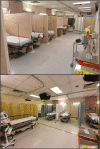Reorganising the emergency department to manage the COVID-19 outbreak
- PMID: 32552659
- PMCID: PMC7298444
- DOI: 10.1186/s12245-020-00294-w
Reorganising the emergency department to manage the COVID-19 outbreak
Abstract
Background: The COVID-19 disease outbreak that first surfaced in Wuhan, China, in December 2019, has taken the world by storm and ravaged almost every country in the world. Emergency departments (ED) in hospitals are on the frontlines, serving an essential function in identifying these patients, isolating them early whilst providing urgent medical care. This outbreak has reinforced the role of Emergency Medicine in public health. This paper documents the challenges faced and measures taken by a tertiary hospital's ED in Singapore, in response to the outbreak.
Main body: The ED detected the first case of COVID-19 in Singapore on 22 January 2020 in a Chinese tourist and also the first case of locally transmitted COVID-19 on 3 February 2020. The patient journeys through the patient reception area in the ED and undergoes fever screening before being shunted to isolation areas within the ED. Management and disposition of suspect COVID-19 patients are guided by a close-knit collaboration between ED and department of infectious diseases. With increasing number of patients, back-up plans for expansion of space and staff augmentation have been enacted. Staff safety is also of utmost importance, with provision and guidelines for personal protective equipment and team segregation to ensure no cross-contamination across staff. These have been made possible with an early setup of an operational command and control structure within the ED, managing manpower, logistics, operations, communication and information management and liaison with other clinical departments.
Conclusion: With the large numbers of undifferentiated patients managed by the ED to date, more than 820 patients with COVID-19 have been identified in the hospital. Not a single member of the staff of the SGH Emergency Department has come down with the illness. The various measures undertaken by the department have helped to ensure good staff morale and strict adherence to safety procedures. We share the lessons learnt so that others who manage EDs around the world can benefit from our experience.
Keywords: COVID-19; Emergency department.
Conflict of interest statement
The authors declare that they have no competing interests
Figures






Comment in
-
A Rapid Transformation of an Existing Testing Facility Area for COVID-19 into a Fully Functional Pediatric Emergency in 72 Hours' Time-An Experience from a Tertiary Care Teaching Hospital.Indian J Pediatr. 2022 Feb;89(2):202-203. doi: 10.1007/s12098-021-04015-w. Epub 2021 Nov 17. Indian J Pediatr. 2022. PMID: 34787793 Free PMC article. No abstract available.
References
-
- https://www.who.int/emergencies/diseases/novel-coronavirus-2019/question... last accessed 9 May 2020.
-
- Government of Singapore. Department of Statistics, Singapore. Population & Population Structure (September 2019). https://www.singstat.gov.sg). Accessed: 6 May 2020.
-
- Government of Singapore. Department of Statistics, Singapore. Labour, Employment, Wages and Productivity (April 2020). https://www.singstat.gov.sg Accessed: 6 May 2020.
-
- Ajay Tandon CJM, Jeremy A Lauer, David B Evans, World Health Organization. Measuring overall health system performance for 191 countries. Year 2000. https://www.who.int/healthinfo/paper30.pdf Accessed: 6 May 2020.
-
- Bloomberg. Where do you get the most for your health care dollar? 18 September 2014. https://www.bloomberg.com/graphics/infographics/most-efficient-health-ca... Accessed: 6 May 2020.
LinkOut - more resources
Full Text Sources

